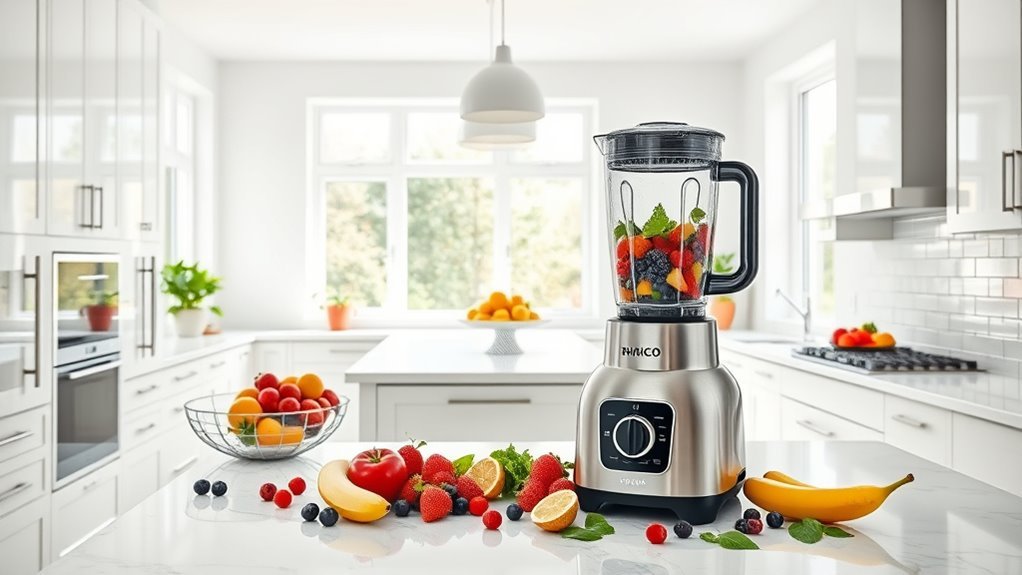We’ve tested the top sound-absorbing materials to tame those noisy 35,000 RPM blender blades. Mass-loaded vinyl provides excellent sound blocking with an STC rating up to 32, while high-density rubber mats cut noise by 50%. Acoustic foam‘s open-cell structure traps high frequencies, and sound-absorbing silicone combined with felt pads tackles vibrations. Add MLV’s dense composition to your setup, and there’s much more to discover about creating your perfect quiet-blending solution.
The Science Behind Blender Noise

Let’s get straight into the chaos happening inside your blender. When those blades spin at a mind-bending 35,000 RPM, they’re creating a perfect storm of unwanted noise.
We’re dealing with impact noise from ingredients getting pulverized, plus sound transmission from the motor‘s intense vibrations.
Here’s the kicker – your fancy granite countertop isn’t doing you any favors in sound absorption. Those hard surfaces actually amplify the racket, creating a symphony of sound blocking challenges that bounce right back at you.
That’s why effective soundproofing materials and acoustic panels are essential for noise reduction. Understanding these sound dynamics helps us target specific soundproofing solutions – because let’s face it, nobody wants their morning smoothie to wake the neighbors. Additionally, high-performance blenders can produce smoother textures while minimizing noise, making them a worthwhile investment for quieter blending experiences.
Mass-Loaded Vinyl for Base Dampening
When it comes to taming blender chaos, Mass-Loaded Vinyl (MLV) stands as your heavyweight champion of sound blocking. With an STC rating up to 32, this flexible material creates a formidable soundproof barrier that’s perfect for base dampening.
We’ve found MLV to be remarkably versatile in noise reduction applications.
Here’s why MLV is your go-to solution:
- Cut to fit any space – perfect for custom soundproof boxes or enclosures
- Dense composition effectively blocks sound waves from reaching your ears
- Combines seamlessly with other materials to maximize acoustic performance
We’ll often layer MLV within walls or create dedicated blender stations for ideal results. Its dense yet pliable nature means we can adapt it to virtually any setup, delivering professional-grade sound blocking without complex installation requirements. Additionally, using MLV can enhance the overall experience of utilizing high-performance blenders, as it allows for quieter blending tasks that won’t disturb others in your home.
High-Density Rubber Mats and Pads

High-density rubber mats and pads serve as your blender’s first line of defense against noise transmission.
We’ve found these soundproofing solutions can slash noise levels by up to 50%, thanks to their superior sound absorption capabilities. The secret lies in their thickness and quality – ranging from 1/4 to 1/2 inch of dense material that traps sound waves before they escape.
What we love about these mats is their easy installation. Most come with self-adhesive backing – just peel and stick under your blender’s feet.
They’re particularly effective at controlling vibrations that would otherwise travel through your countertop, helping to minimize amplification of countertop noise.
Whether you’ve got granite, stainless steel, or any other hard surface, these mats create an essential barrier between your blender and its environment.
Acoustic Foam Enclosure Materials
Three key properties make acoustic foam the ultimate solution for blender noise control. Its open-cell structure converts sound energy into heat, effectively trapping those pesky high-frequency sounds your blender produces.
We’ve found acoustic foam to be incredibly versatile for creating soundproof boxes that’ll transform your blending experience.
Here’s why we’re convinced acoustic foam is your best bet:
- Lightweight yet powerful sound-absorbing materials that adapt to any enclosure shape
- Fire-resistant properties make it safe for kitchen environments
- Available in various thicknesses for ideal sound dampening based on your needs
When properly installed in a custom enclosure, acoustic foam creates a dramatic reduction in blender noise.
You’ll wonder how you ever tolerated the racket before.
Sound-Absorbing Silicone and Felt Solutions
Revolutionary silicone and felt solutions have transformed the way we tackle blender noise reduction.
We’re seeing remarkable results with high-density silicone mats, typically 1/4 to 1/2 inch thick, that effectively absorb sound and minimize vibrations. When we combine these with strategic felt pad installation under blender feet, we’re creating a powerful acoustic barrier.
These materials aren’t just effective – they’re built to last. The durability of both silicone and felt means you’ll get consistent performance in your kitchen, whether you’re blending at home or in a commercial setting.
We’ve found that using both solutions simultaneously delivers the best results, considerably reducing operational noise. It’s a simple but powerful approach to creating a quieter, more pleasant food preparation environment.
Frequently Asked Questions
What Is the Best Material for Low Frequency Sound Absorption?
We’ve found mass loaded materials and acoustic panels work best for low frequencies, especially when combined with thick foam insulation, bass traps, and sound blankets for maximum absorption and dampening.
What Material Absorbs Sound the Most?
When push comes to shove, we’ve found acoustic glass mineral wool to be the champion of sound absorption, outperforming soundproof curtains, foam tiles, and mass loaded barriers in noise reduction tests.
What Materials Are Best for Muffling Sound?
We’ll get the best sound muffling using mass loaded vinyl barriers, acoustic panels, heavy drapes, and foam tiles. For complete noise reduction, add carpet padding and acoustic caulking between surfaces.
How to Soundproof a Blender?
Let’s hush that noisy beast! We’ll place dense rubber mats underneath, attach dampening pads to feet, and create a homemade sound barrier using acoustic foam-lined enclosures for effective blender noise control.

